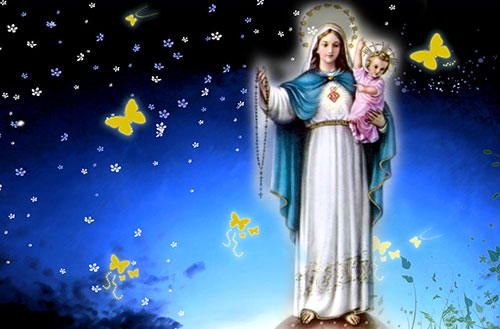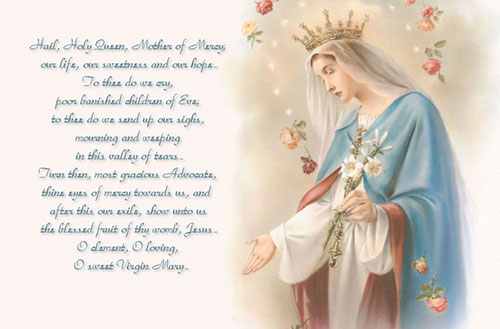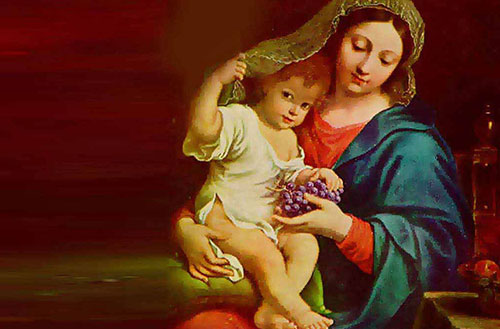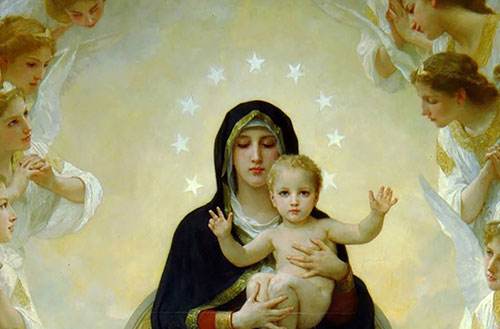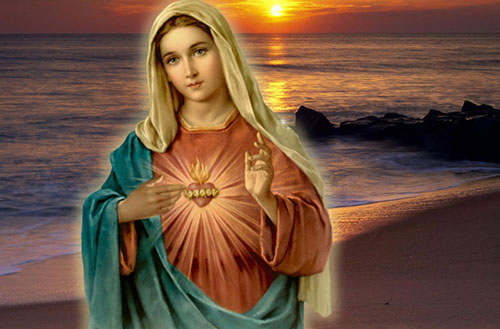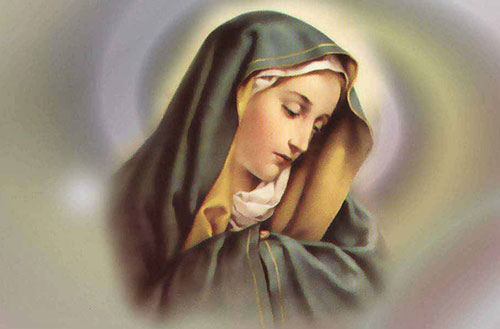Mother Mary Wallpapers
A central figure
Mary has always been a central figure in Christianity. She's always been absolutely key, right from that moment early in Luke's Gospel when she's told "Blessed are you amongst women". The interesting thing for modern scholars is that she's being reassessed because we've become much more sensitive to female characters in the biblical story and because female characters in the biblical story are often quieter than the men. In a contemporary world we want to reimagine Christian origins and involve women much more. And one of the most important women in that story is Mary, of course, and that's why it's worth hearing her voice in a fresh way.
One of the reasons that Mary has maintained her popularity is that there were all the makings in the biblical text for a fascinating story, and yet with much of the detail missing. Often when details are missing, tradition will do its own part in trying to fill in those details and imagine those details to make that person's life a little bit fuller and understand a bit more about them.
Reflecting on stained glass images of Mary in a Norfolk church, Sister Wendy Beckett thinks that Mary's popularity in the Middle Ages was due to her depiction as a caring mother.
One of the roles that Mary fulfils is the mother that we see in early Christianity; she's the role model for mothers. She also plays an important role throughout Christian history in providing us with a female that's right at the heart of events. Christianity, after all, can be a fairly male-dominated affair. The Holy Trinity always sounds to contemporary feminists rather male dominated; there's a Father, a Son and there's a Holy Spirit, and the characters in the New Testament are all male. But here we actually have somebody who we can interact with as a female in Christian tradition.
Pagan images of Mary
Many people, Protestants particularly, object to the figure that Mary has become. She is seen almost as a goddess figure, possibly derived from the fact that many Pagans became Christians in the early centuries of the church and they believed in goddesses, so Mary became to them the goddess. Many people would say that was something that went wrong with Christianity. There's nothing about Mary being a goddess in the New Testament.
Jesus is God and human so therefore Mary is simply human. Christian theology has always maintained that she was a human being and not God, but nevertheless, she was a human being in a very important and intimate place in the story of Jesus.
There have been many images of Mary through the centuries. Some have derived from the Bible, such as the image from the book of Revelation showing Mary with a crown of 12 stars. She represents the early church with the 12 tribes of Israel represented by the stars.
There have been images of Madonna and child; Mary seated in a chair with the child on her lap. Some of these images look very similar to images that we know about from some of the pagan goddesses at the time.
Isis, for example, was seated in such a chair with the infant Horus on her lap in the same way.
When Christianity was spreading across the Empire, it's clear that it deliberately took images from the pagan world in which it lived and into which it spread and used those images. Old holy wells and shrines were turned into Christian shrines. In Egypt a shrine of Isis was deliberately and self-consciously re-created as a shrine of Mary.
One of the important cities for Mary was Ephesus, where the goddess Diana was worshipped. It's not surprising that Mary drew upon the imagery associated with the goddesses, because that was the imagery the people knew. In the same way, we have imagery of Christ with a triumphant crowd looking like an emperor.
Betrothal and marriage
Later Rabbinic sources tell us that Jewish girls could be betrothed as early as 12 years and a day or any time after the age of twelve and a half.
The actual marriage involved two stages. First of all there was the betrothal and then - after an interval of several months, perhaps a year - the young girl would have been taken to the house of her husband to be and at that moment, once they started to live together, they were considered properly married.
This could have been quite a traumatic process for a young girl; to leave behind her mother and father and all the people she was used to, and go to live in an alien household.
The choice of husband was made by the family, not by the girls themselves. It was a legal agreement between the father and the husband. Girls did not have a part in that legality.
Pregnant out of wedlock
A girl who became pregnant out of wedlock would have been terrified. The whole social structure was set up for children to be born within marriage. Genealogy and ownership of children was seen as very important. Girls who became pregnant outside marriage would probably have had to leave their homes and their families.
There was the potential of being sold into slavery or of being stoned to death. She may have been married off quickly or banished from her home and village, which may have led a women to prostitution or slavery when she had no way of supporting herself. According to the New Testament Joseph, after being visited by an angel, decided not to send her away or to expose her but to marry her.
Women in Mary's time
Jewish women in first century Palestine had very limited legal and economic rights. It's particularly in the domain of economic rights that this is a big problem. When a girl was in the household of her father, any work that she did or wages that she earned would belong to her father. Once she married, her wages and products that she made belonged to her husband. There were very few times when she would have any sense of financial and economic autonomy.
A woman didn't have the right to divorce her husband, but he could divorce her. If she divorced she would lose her children as well. Most inheritances that she received would go straight to her husband. The husband would maintain legal responsibility for the children.
We have multiple sources for knowing about women's lives in 1st century Roman Palestine. There are literary sources such as the Bible, texts from writers such as Josephus and Pliny and the Apocryphal texts (although these have to be read with a pinch of salt as they refer to a slightly later time). There are the early Rabbinic materials, which provide a good deal of information. There's also archaeological evidence and material culture to give us clues about how women lived and what kind of houses they lived in. There is a great deal of information about Roman women's lives in Roman texts and novels throughout the provinces of Rome.
Mary, like most Jewish women and girls of her time, would have spent most of her day working. Almost as soon as she could walk she would have been helping out with the many chores it took to keep daily life going. Stoves needed to be tended, beds needed to be made, homes need to be kept in repair, food needed to be prepared, animals needed to be tended whether one was on a farm or in a village. Food needed to be prepared for the future, so meat and vegetables needed to be preserved for future times as well. Water had to be drawn from cisterns and from wells. An incredible amount of work had to be done every day and it was done primarily by women and girls.
People at this time ate a fairly straightforward diet. Most days people would have eaten lots of bread from wheat or barley, cereals or gruels. Olives, dates and figs were also eaten. Meat was eaten every now and again, usually after a big festival and the slaughtering of a lamb or goat. A lot of wine was drunk too.
Political situation
Politically Mary would have lived at quite a difficult time. She would have seen the end of the reign of Herod the Great and all the revolts that accompanied the end of his reign. She would have seen the Roman Legions coming in to Galilee to put down these revolts and all the atrocities associated with the legions.
We know from Jewish writings of the time that the Romans burnt cities and took people away into slavery. Galilee was politically fairly stable throughout most of Jesus' lifetime but there would have been isolated pockets of resistance and certainly no one would have liked the idea that Judea to the south was a Roman province, or that the Romans were present in the Holy City of Jerusalem and in the temple itself.
Galilee in the 20s was occupied by Romans and would have been an oppressing place for the Jews. If a Roman soldier said "you've got to carry my backpack one mile", they'd have to do it; they had no option. The Romans forced the Jews to pay taxes to Caesar. At night they might have heard the soldiers march by with their swords clanging, and they would have been afraid.
One can imagine there was talk about trusting in God and that maybe in their lifetime he would send a Messiah. The Jews, as they became more and more oppressed, may have became more and more obsessed with God. They may have thought that this could be the time for the Saviour to come. And it was in this highly charged theological atmosphere that Mary wove her way to the well, perhaps holding in her arms the infant Jesus.
Mary's virginity and immaculate conception
The immaculate conception of Mary has no historical basis at all. This is something that was invented by later Christians to extend the idea of her holiness. The purity, the perpetual virginity, all of those kind of themes end up with Mary (as well as Jesus) having to be conceived immaculately. One of the difficulties that many people today have with the virgin birth is not so much historical, the idea that it couldn't happen, but theological; the idea that it must have happened in order for Jesus not to have had any sin.
Early Christians like Augustine tended to think that Adam's original sin was passed on in the act of sex and that therefore in order for Jesus to be holy and sinless it was necessary for him not to have been born from parents who had had sex. Theologically people now have more problems with the Virgin Birth than they would have done in the past. In the past it was almost necessary to have a virgin birth in order to get Jesus out of this rather sticky difficulty of having been born with ordinary human parents who'd had sex.
In the New Testament, many of the women characters are either so holy and pure that it's unrealistic, or they're prostitutes. And Mary falls into the category of being holy and pure and absolutely without sin; and she carries on in that trajectory right through the tradition so that she gets more and more holy and her virginity is stressed more and more and her holiness throughout her whole life is stressed, so that she too becomes sinless. She is assumed into heaven rather than having to die, she herself gets born of an immaculate conception; so you get a development in the idea of the perpetual virginity, because she's begun a journey to becoming ever more holy, ever more pure which in the end can only end up with those concepts of perpetual virginity.
Origin of the virgin birth story
The virgin birth is a very powerful story which explains the theological truth that Jesus is the son of God - not just the son of God from his resurrection or from his baptism, as perhaps the gospel of Mark might suggest, but the son of God from the moment of his conception.
To what extent it's historical is much more difficult to analyse. One of the difficulties is that we hear nothing at all of a virgin birth tradition, until late in the first century. Only in the gospels of Matthew and Luke, which were probably written in the 80s or 90s of the first century, is there a mention of the virgin birth.
Another difficulty with the virgin birth idea is that the texts in Matthew and Luke are clearly overlaid with references to the Old Testament. They're evocative of the typical Old Testament annunciation narrative: the angel going down to one or two of the parents; the insurmountable problem, which usually in the Old Testament is the fact that the parents are elderly or barren; the angel proclaiming that the problem is going to be surmounted; and the birth ensues. It's very similar to the stories about the birth of Isaac or the birth of Samson or Samuel. Matthew and Luke are indebted to the Old Testament and they're drawing on these Old Testament ideas. The story of the birth of Jesus has to be even better. Mary can't be an elderly barren woman: instead she's a young girl who's also a virgin.
Miraculous birth
There were lots of stories of miraculous births in Greco-Roman society. Famous figures tended to attract these stories as people speculated on what it would have been like to be present at the birth of such a person. Astrology was also important, so it was felt that if a person was going to be very prominent their fate was already preordained, that in their horoscope one would see how wonderful they were going to be. It's not surprising they began to think that perhaps their birth was miraculous and wonderful.
In the Greek and Roman system of gods and goddesses, the goddesses themselves could be said to be virgin mothers. Athene and Artemis were regarded as virgins. They gave birth and then dipped themselves into the rivers so their virginity was renewed.
The Greek and Roman stories are not quite the same as the virgin birth stories in the gospels. They differ in that there's a male god and a human mother and the male god comes down to earth and impregnates the mother in a very graphic way. In the gospel stories there's no mention of God or the Holy Spirit taking the form of a human being and actually coming down and impregnating Mary.
Rape
There was an ancient legend from the Jewish side that Mary was the victim of a rape. They even gave us the name of the Roman soldier who was supposed to have carried out this rape: a man called Panthera, which apparently was quite a common name for Roman soldiers.
Recently some scholars looked at this theory and decided it was simply an ancient slur, anti-Christian slander made up in the second century to try to prevent belief in Jesus. Some say that perhaps it isn't so impossible as previously we thought. There are certain clues in the New Testament to suggest that Mary was in quite a terrible state after the beginning of the pregnancy. The fact that she went in great haste to see Elizabeth. The fact that she talks about herself as a "lowly handmaid": why is she lowly? Some people believe the lowliness was because she was actually the victim of a crime.
The strength of the idea is that just as Jesus in his crucifixion identifies with those who suffer, Mary, as victim of rape, is somebody that women who suffer can identify with.
The problem of the theory is that Jesus could have been the son of a Roman soldier, which is even more unpalatable for people than the idea that Mary wasn't a virgin. The idea that Jesus was somehow genetically dependent upon a rapist is more difficult to swallow and it would take a tremendous radical leap of faith to accept that kind of theory.
Virginity throughout the birth
The book of James establishes that Mary was a virgin during the birth of Jesus - in other words she remained intact, physically, despite the birth, which is miraculous. It led to later speculation that Mary remained a virgin throughout her life, before her pregnancy, during the birth of Jesus, and after. The book of James begins to speculate on the birth of Jesus in quite graphic detail.
The idea that Mary is intact comes from the idea that she suffers no pain. This is theologically important to the early Christians because of the curse, mentioned in Genesis, of the two human beings who are responsible for the fall. Adam's curse is to work in sweat in the fields and Eve's curse is to bear children in pain. The idea that Mary and Jesus are free of sin, that they are immaculate, leads us to think that Mary wouldn't suffer the pain of Eve, that she would have a painless birth.
Some would argue that this makes her rather distant from the ordinary woman. The way that the tradition has dealt with that is to say she had a painless birth but she wasn't without pain because she saw her son die on the cross.
The great tradition of Mary as the "Mother of Sorrows" comes into being and there are often depictions of Mary as a woman in tears, of a woman laid low by grief. John's gospel refers to the crucifixion as a laborious birth, so if Mary does have a painful birth in the Christian tradition she has it at the crucifixion.
Second hand merchandise
The word virgin developed in western culture has become a synonym for purity and good behaviour. But virginity in Jewish society at the time that we are talking about was about ensuring that the new husband wasn't getting second hand merchandise. Virginity was only important for the moment of the first marriage.
The first marriage was more important; for example, in the Jewish marriage contract for a first marriage they paid twice as much as for a second marriage. Virgins went out on the wedding procession with their hair open and flowing so that everyone could see and it would then be remembered that she had been a virgin when she entered her husband's house at that event.
In fact after a while, instead of being a prize, virginity became a burden. We know this from several Jewish burial inscriptions where women were buried and the messages of mourning on their tomb say how sad it was that she died a virgin.
Jesus's siblings
From the first century to the present day there has been a debate about Jesus having brothers and sisters.
According to the Gospels of Matthew, Mark and Luke, Jesus had at least four brothers who survived into the time when he was an adult. In Mark's Gospel, when Jesus goes to Nazareth to speak in the Synagogue the people in the crowd say to him, "Isn't this Mary's son and the brother of James, Joseph, Judas and Simon?". They also say, "Are not his sisters here with us?" So there are at least two sisters and possibly more.
Regularly mentioned by Paul and sometimes mentioned by other early Christian writers, was Jesus's brother James. James seems to have had a very important role in running the church from very early on in Jerusalem but it's a role that's become forgotten in later Christian tradition.
Later Christian traditions have redefined these brothers and sisters, either as cousins or as Joseph's children by an earlier marriage, in order to preserve the idea of Mary's perpetual virginity.
Was Mary at the crucifixion?
It is quite likely that Mary was present at the Crucifixion. Mary is only explicitly said to be at the Cross in John's gospel but there are hints that she was there in the other gospels.
In John's Gospel she's actually placed at the Crucifixion; Mary stands with the disciples, and they're entrusted to one another's care by the dying Jesus from the cross. But it's unlikely that Jesus would have been able to communicate with anyone from the cross. In the other gospels the relatives of Jesus stand at a distance and Jesus wouldn't have been able to have a conversation with them.
What does seem to be historically accurate is that Mary was in Jerusalem at this time. She could conceivably have been at the crucifixion.
It's difficult to work out what happened to Mary after Jesus' crucifixion. The last reference there is to her comes early in Luke's second volume, The Acts of the Apostles. Luke was the only one of the gospel writers to write a second volume. He mentions Mary being in Jerusalem not long after the crucifixion. The other possibilities are either that she went home to Nazareth and went to live with family there, or she went to Ephesus and lived with the "beloved disciple" who's mentioned in John's gospel.
One possibility is that Mary went to Ephesus some time after Jesus' death and resurrection. The reason for this theory is that John, the Beloved Disciple, is supposed to have written his gospel from there and this same John is said to have been at the cross with Mary when Jesus entrusted each of the disciples to each other. Ephesus is relatively unlikely to be the place where Mary went. The idea is purely based on the tradition of her association with John and John's gospel.
The other possibility is that Mary simply stayed in Jerusalem after the crucifixion. The reasoning for this is that we know James, her son (or her step-son), was there. Moreover, when James died, a cousin of Jesus' called Simeon became the next leader of the Church in Jerusalem. This suggests that there was a family enclave in Jerusalem. If this is the case then it makes it quite likely that Mary was one of the people who stayed there and held them all together.
Mary may have died not long after Jesus' death and resurrection. Even if she was very young when she gave birth to Jesus she would have been in her forties, at the youngest, at this stage, which is already very good by ancient life expectancy, especially for a woman who's given birth.
A meditation on Mary's presence at the Crucifixion
Sarah Jane Boss, Director of the Centre for Marian Studies at the University of Wales, Lampeter, considers the role of Mary in the Christian story.
After the crucifixion
The story of Mary after the beginning of Acts is not known but there are traditions about it and it's important as part of the Christian story.
Mary was associated with a beloved disciple in John's gospel and Jesus says the beloved disciple is to take her to his home. Women had to be looked after by men in that society so when Jesus could no longer look after her, the beloved disciple looks after her. The beloved disciple, who is not named in John's gospel, is identified later as being John.
Traditions vary. One tradition is that Mary stayed in Jerusalem, died in Jerusalem and Jerusalem claims her tomb. So in a sense Jerusalem claims that Mary was the mother of the church in Jerusalem and James stayed in Jerusalem. But James himself had to flee Jerusalem when things got very difficult so perhaps Mary had to leave Jerusalem at some point. In another tradition the disciple John goes to Ephesus and it's assumed that Mary would have gone with him and spent the rest of her life in Ephesus. At the beginning of the 19th century an interesting German nun had a vision about Mary's life. In that vision she saw Mary's life ending in Ephesus and she also described the house where Mary lived. As a result of that vision archaeologists dug up a house which is very similar to the one she described and this is now revered as Mary's house.
New Testament evidence
The story of Mary comes in all sorts of different contexts of the New Testament and we have to piece the different bits together. Matthew tells us a little bit, Luke tells us some different things, Mark doesn't tell us very much, John tells us some different things again. It's not one big coherent story that takes you from her birth to her death. We just have little spotlights of certain parts of her life.
The New Testament is quite disappointing in some ways because it doesn't tell us as much about Mary as we'd like to know. The place that we find most about Mary from is Luke's gospel. Luke thinks that Mary is one of the key characters in the drama so he tells the whole story of Jesus' birth from Mary's perspective. In particular, Luke writes about the time of the conception of Jesus and exactly what Mary was thinking, what she was doing, what her reactions were when the Angel Gabriel talked to her.
Other parts of the New Testament tend to be rather negative about Mary. Matthew tells the story from a traditional male perspective. He sees the whole story from Joseph's perspective. Mark's gospel tends to lump her together with Jesus' family and regards her as being someone who stands in the way of Jesus and his gospel and his message.
The gospel writers don't actually want to tell very much about Mary unless the action is really revolving around something important about Jesus.
Mary does appear outside the New Testament, but the documents start looking very much like pieces of ancient fiction. The best source for her is a document from the second century called the Proto-Evangelium of James. It's a parochial text and it talks in great detail about her parents, her upbringing, her age when she conceived Jesus and so on. The disappointing thing about it is that most of it is probably made up.
The fact that Mary is in the New Testament at all is significant because it deals with Jesus and the growth of the early church; there's actually very little reason to mention anything at all about Mary. The New Testament tells us very little about his father Joseph so the fact that she's prominent shows that there was some interest in Mary in the early church years.
It is important to remember that all of the gospels were written significantly later than the death of Jesus. Matthew and Luke, who do refer to Jesus' birth, were probably written almost a century later than his birth. Each of the gospels was composed in a different environment at a different time with particularly different interests in mind. Each one of them has a slightly different theological overtone, each of them is writing for slightly different purposes and thus each has its own particular traits.
There are very few references to Mary outside the New Testament. Later Jewish writings refer to her by her Jewish name, Miriam, and say that she's a hairdresser and that Jesus is the illegitimate son of a Roman soldier called Panthera. The problem with these references is they are at least from the 200s - quite possibly as late as the 500s - so they're substantially later than the New Testament and probably reflect a lot of the hostility between Jewish and Christian groups at that late date.
 DONATE NOW - UPI
DONATE NOW - UPI

